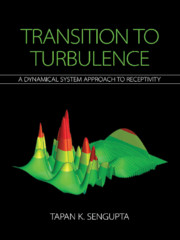Book contents
- Frontmatter
- Dedication
- Contents
- Preface
- 1 Receptivity, Instability, and Transition: A Perspective
- 2 Dynamical System Theory and Role of Equilibrium Flows
- 3 Fundamentals of Scientific Computing
- 4 Instability and Transition
- 5 Receptivity Analysis: Relation with Instability Experiments
- 6 Dynamical System Theory of Linear Receptivity
- 7 Nonlinear, Nonparallel Effects on Receptivity, Instability, and Transition
- 8 Three-Dimensional Routes of Transition to Turbulence
- 9 Receptivity to Free Stream Excitation: Theory, Computations, and Experiments
- 10 Nonlinear Receptivity Theories: Hopf Bifurcations and Proper Orthogonal Decomposition for Instability Studies
- 11 Mixed Convection Flow
- 12 Baroclinic Instability: Rayleigh–Taylor Instability
- 13 Coherent Structure Tracking in Transitional and Turbulent Flows
- 14 The Route of Transition to Turbulence: Solution of Global Nonlinear Navier–Stokes Equation
- References
8 - Three-Dimensional Routes of Transition to Turbulence
Published online by Cambridge University Press: 16 February 2021
- Frontmatter
- Dedication
- Contents
- Preface
- 1 Receptivity, Instability, and Transition: A Perspective
- 2 Dynamical System Theory and Role of Equilibrium Flows
- 3 Fundamentals of Scientific Computing
- 4 Instability and Transition
- 5 Receptivity Analysis: Relation with Instability Experiments
- 6 Dynamical System Theory of Linear Receptivity
- 7 Nonlinear, Nonparallel Effects on Receptivity, Instability, and Transition
- 8 Three-Dimensional Routes of Transition to Turbulence
- 9 Receptivity to Free Stream Excitation: Theory, Computations, and Experiments
- 10 Nonlinear Receptivity Theories: Hopf Bifurcations and Proper Orthogonal Decomposition for Instability Studies
- 11 Mixed Convection Flow
- 12 Baroclinic Instability: Rayleigh–Taylor Instability
- 13 Coherent Structure Tracking in Transitional and Turbulent Flows
- 14 The Route of Transition to Turbulence: Solution of Global Nonlinear Navier–Stokes Equation
- References
Summary
Introduction
By now what has been established is: (a) The onset of instability is due to the growth of imperceptible background disturbances for the canonical zero pressure gradient boundary layer or the boundary layer formed over a semi-infinite flat plate. Here, the connotation of zero pressure gradient has to be understood in the context of the discussions in Section 7.3; that the streamwise pressure gradient on the semi-infinite flat plate is variable in nature, as shown in Figure 7.8. The transition that the semi-infinite flat plate undergoes will be a strong function of the flow receptivity depending on the location of the exciter with respect to the leading edge of the plate. For the same reason, results reported in literature or books that employ the Blasius boundary layer should be viewed as pedagogic exercises primarily [133, 388] with poor reliability. (b) For experimental verification of instability theories, one has to follow a receptivity approach, with respect to deterministic excitation, for this allows replicability of the experiment. (c) Such experiments have to be for the conditions of the theory, just as it has been for the spatial instability theory, which requires that time periodic excitation be inside the boundary layer, even though the real excitation is completely different from such monochromatic excitation. This has led to the incorrect identification of TS waves as the precursors of natural transition to turbulence, and misdirecting researchers right from the beginning of the twentieth century. (d) Even when conducting experiments based on time aperiodic excitation [96, 144, 290], researchers and experimenters always tried to locate TS waves to explain their experiments. (e) However, when researchers investigated further for more generic spatio-temporal route of transition using linear theory, the concept of spatio-temporal wave front (STWF) emerged in [418, 451], which was later identified by solving the Navier–Stokes equation without linearization [419, 422]. Variety of researchers have tried to explain such events as due to transient growth and/or bypass transition [299, 364], or by nonmodal growth [229, 398, 532] and so on.
The generic nature of STWF for seemingly different routes of transition via alternate routes for two-dimensional transition has been explained in the previous two chapters and is based upon research by Sundaram et al. [509]. The researchers no longer have to go looking for TS waves for every episode of transition.
Information
- Type
- Chapter
- Information
- Transition to TurbulenceA Dynamical System Approach to Receptivity, pp. 248 - 287Publisher: Cambridge University PressPrint publication year: 2021
